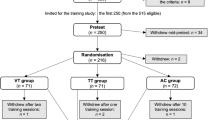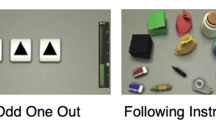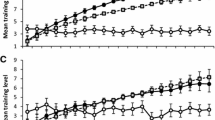Abstract
Previous research has demonstrated that adaptive training of working memory can substantially increase performance on the trained task. Such training effects have been reported for performance on simple span tasks, complex span tasks, and n-back tasks. Another task that has become a popular vehicle for studying working memory is the change-detection paradigm. In a typical change-detection trial, one has to determine whether a set of stimuli is identical to a set that was presented just previously. Here, we developed an adaptive training regimen comprised of increasingly difficult change-detection trials to assess the degree to which individuals’ change-detection performance can be improved with practice. In contrast to previous work, our results demonstrate that participants are able to dramatically improve their performance in change detection over the course of 10 training sessions. We attribute this improvement to the current training method that adaptively adjusted the set size of the change-detection task to the proficiency of the trainee. Despite these considerable training effects, an exploratory investigation revealed that these improvements remained highly task specific and may not generalize to untrained tasks.





Similar content being viewed by others
Notes
We note at this point that definitions of WM often stress the involvement of storage and processing components (e.g., Oberauer 2005). The change-detection paradigm is commonly described as a WM task, although it relies more on a storage than a processing component.
In a two-back task for example, a one-back target and a three-back target both constitute a lure.
The corresponding RGB values were black (0, 0, 0), blue (0, 0, 255), green (0, 128, 0), purple (128, 0, 128), red (255, 0, 0), white (255, 255, 255), and yellow (255, 255, 0).
Note that due to the variation in computer hardware, the stimulus size (as expressed in degrees of visual angle) could vary between participants because of different screen sizes and screen resolutions.
Concerning the modeling approaches, we note that for the spatial resolution task, the appropriateness of the model is reflected in both the small number of “error” trials detected (M = 4.9 out of 115 trials; SD = 4.4) and the high test-retest reliability of the resulting precision statistics (1/sd of pre-training vs post-training point distributions was correlated r = 0.81; after each participant was fitted with the model the corresponding 1/SD precision score correlation improved to r = 0.88). The correlation between the number of trials categorized as guesses was also significantly correlated pre- and post-test (r = 0.65; t(38) = 5.2, p < 0.001). For the color resolution task, substantially more trials were categorized as guesses (M = 20.8 out of 125 trials; SD = 10.8), and the precision value (kappa) fitted to each participant (assuming no guessing) had a similar test-retest correlation (r = 0.56 for the raw scores; r = 0.52 for the mixture model). Interestingly, the correlation between the number of trials categorized as guess was higher than the precision scores (r = 0.73).
Note that we present BF10 in the tables.
References
Ackerman, P. L. (1987). Individual differences in skill learning: an integration of psychometric and information processing perspectives. Psychonomic Bulletin & Review, 102(1), 3–27.
Agostinelli, C., & Lund, U. (2013). R package “circular”: Circular Statistics (Version 0.4–7). Retrieved from https://r-forge.r-project.org/projects/circular/
Au, J., Katz, B., Buschkuehl, M., Bunarjo, K., Senger, T., Zabel, C., et al. (2016). Enhancing working memory training with transcranial direct current stimulation. Journal of Cognitive Neuroscience, 28(9), 1419–1432. https://doi.org/10.1162/jocn_a_00979.
Ball, K., Berch, D. B., Helmers, K. F., Jobe, J. B., Leveck, M. D., Marsiske, M., et al. (2002). Effects of cognitive training interventions with older adults: a randomized controlled trial. JAMA: The Journal of the American Medical Association, 288(18), 2271–2281.
Benjamini, Y., & Hochberg, Y. (1995). Controlling the false discovery rate: a practical and powerful approach to multiple testing. Journal of the Royal Statistical Society Series B (Methodological), 57(1), 289–300.
Bjork, E. L., & Bjork, R. A. (2014). Making things hard on yourself, but in a good way: creating desirable difficulties to enhance learning. In Psychology and the real world: Essays illustrating fundamental contributions to society (2nd ed., pp. 59–68). New York (NY, USA): Worth.
Boduroglu, A., & Shah, P. (2009). Effects of spatial configurations on visual change detection: an account of bias changes. Memory & Cognition, 37(8), 1120–1131. https://doi.org/10.3758/MC.37.8.1120.
Boduroglu, A., Mueller, S., Ng, A., & Shah, P. (submitted). Representation resolution is correlated with short-term memory capacity.
Bors, D. A., & Vigneau, F. (2001). The effect of practice on Raven’s advanced progressive matrices. Learning and Individual Differences, 13(4), 291–312. https://doi.org/10.1016/S1041-6080(03)00015-3.
Chein, J. M., & Morrison, A. B. (2010). Expanding the mind’s workspace: training and transfer effects with a complex working memory span task. Psychonomic Bulletin & Review, 17(2), 193–199. https://doi.org/10.3758/PBR.17.2.193.
Conway, A. R., Kane, M. J., Bunting, M. F., Hambrick, D. Z., Wilhelm, O., & Engle, R. W. (2005). Working memory span tasks: a methodological review and user’s guide. Psychonomic Bulletin & Review, 12(5), 769–786.
Cowan, N. (2001). The magical number 4 in short-term memory: a reconsideration of mental storage capacity. Behavioral and Brain Sciences, 24, 87–185.
Cowan, N., Elliot, E. M., Saults, J. S., Morey, C. C., Mattox, S., Hismjatullina, A., & Conway, A. R. A. (2005). On the capacity of attention: its estimation and its role in working memory and cognitive aptitudes. Cognitive Psychology, 51, 42–100.
Cowan, N., Fristoe, N. M., Elliott, E. M., Brunner, R. P., & Saults, J. S. (2006). Scope of attention, control of attention, and intelligence in children and adults. Memory & Cognition, 34(8), 1754–1768.
Dempster, A. P., Laird, N. M., & Rubin, D. B. (1977). Maximum likelihood from incomplete data via the EM algorithm. Journal of the Royal Statistical Society, Series B, 39(1), 1–38.
Deveau, J., Ozer, D. J., & Seitz, A. R. (2014). Improved vision and on-field performance in baseball through perceptual learning. Current Biology, 24(4), R146–R147.
Dosher, B. A., Jeter, P., Liu, J., & Lu, Z.-L. (2013). An integrated reweighting theory of perceptual learning. Proceedings of the National Academy of Sciences of the United States of America, 110(33), 13678–13683. https://doi.org/10.1073/pnas.1312552110.
Eng, H. Y., Chen, D., & Jiang, Y. (2005). Visual working memory for simple and complex visual stimuli. Psychonomic Bulletin & Review, 12(6), 1127–1133.
Ericsson, K. A., Chase, W. G., & Faloon, S. (1980). Acquisition of a memory skill. Science, 208, 1181–1182.
Fahle, M., & Morgan, M. (1996). No transfer of perceptual learning between similar stimuli in the same retinal position. Current Biology: CB, 6(3), 292–297.
Fukuda, K., Awh, E., & Vogel, E. K. (2010a). Discrete capacity limits in visual working memory. Current Opinion in Neurobiology, 20(2), 177–182. https://doi.org/10.1016/j.conb.2010.03.005.
Fukuda, K., Vogel, E., Mayr, U., & Awh, E. (2010b). Quantity, not quality: the relationship between fluid intelligence and working memory capacity. Psychonomic Bulletin & Review, 17(5), 673–679. https://doi.org/10.3758/17.5.673.
Gaspar, J. G., Neider, M. B., Simons, D. J., McCarley, J. S., & Kramer, A. F. (2013). Change detection: training and transfer. PLoS One, 8(6), e67781. https://doi.org/10.1371/journal.pone.0067781.
Jaeggi, S. M., Seewer, R., Nirkko, A. C., Eckstein, D., Schroth, G., Groner, R., & Gutbrod, K. (2003). Does excessive memory load attenuate activation in the prefrontal cortex? Load-dependent processing in single and dual tasks: functional magnetic resonance imaging study. NeuroImage, 19(2 Pt 1), 210–225.
Jaeggi, S. M., Buschkuehl, M., Jonides, J., & Perrig, W. J. (2008). Improving fluid intelligence with training on working memory. Proceedings of the National Academy of Sciences of the United States of America, 105(19), 6829–6833. https://doi.org/10.1073/pnas.0801268105.
Jaeggi, S. M., Buschkuehl, M., Shah, P., & Jonides, J. (2014). The role of individual differences in cognitive training and transfer. Memory & Cognition, 42(3), 464–480. https://doi.org/10.3758/s13421-013-0364-z.
JASP Team. (2017). JASP (Version 0.8.2). https://jasp-stats.org/faq/how-do-i-cite-jasp/.
Johnson, M. K., McMahon, R. P., Robinson, B. M., Harvey, A. N., Hahn, B., Leonard, C. J., et al. (2013). The relationship between working memory capacity and broad measures of cognitive ability in healthy adults and people with schizophrenia. Neuropsychology, 27(2), 220–229. https://doi.org/10.1037/a0032060.
Karbach, J., & Verhaeghen, P. (2014). Making working memory work: a meta-analysis of executive control and working memory training in younger and older adults. Psychological Science, 25(11), 2027–2037. https://doi.org/10.1177/0956797614548725.
Klingberg, T., Fernell, E., Olesen, P. J., Johnson, M., Gustafsson, P., Dahlström, K., et al. (2005). Computerized training of working memory in children with ADHD—a randomized, controlled trial. Journal of the American Academy of Child & Adolescent Psychiatry, 44(2), 177–186. https://doi.org/10.1097/00004583-200502000-00010.
Kundu, B., Sutterer, D. W., Emrich, S. M., & Postle, B. R. (2013). Strengthened effective connectivity underlies transfer of working memory training to tests of short-term memory and attention. The Journal of Neuroscience, 33(20), 8705–8715. https://doi.org/10.1523/JNEUROSCI.5565-12.2013.
Kuo, C.-C., Zhang, C., Rissman, R. A., & Chiu, A. W. L. (2014). Long-term electrophysiological and behavioral analysis on the improvement of visual working memory load, training gains, and transfer benefits. Journal of Behavioral and Brain Science, 04(05), 234–246. https://doi.org/10.4236/jbbs.2014.45025.
Lin, P.-H., & Luck, S. J. (2012). Proactive interference does not meaningfully distort visual working memory capacity estimates in the canonical change detection task. Frontiers in Psychology, 3, 42. https://doi.org/10.3389/fpsyg.2012.00042.
Morrison, A. B., & Chein, J. M. (2011). Does working memory training work? The promise and challenges of enhancing cognition by training working memory. Psychonomic Bulletin & Review, 18(1), 46–60. https://doi.org/10.3758/s13423-010-0034-0.
Oberauer, K. (2005). The measurement of working memory capacity. In O. Wilhelm & R. W. Engle (Eds.), Handbook of understanding and measuring intelligence (pp. 393–407). Thousand Oaks: Sage Publications.
Olson, I. R., & Jiang, Y. (2004). Visual short-term memory is not improved by training. Memory & Cognition, 32(8), 1326–1332.
Olson, I. R., Jiang, Y., & Sledge Moore, K. S. (2005). Associative learning improves visual working memory performance. Journal of Experimental Psychology Human Perception and Performance, 31(5), 889–900. https://doi.org/10.1037/0096-1523.31.5.889.
Owens, M., Koster, E. H. W., & Derakshan, N. (2013). Improving attention control in dysphoria through cognitive training: transfer effects on working memory capacity and filtering efficiency. Psychophysiology, 50(3), 297–307. https://doi.org/10.1111/psyp.12010.
Phillips, W. A. (1974). On the distinction between sensory storage and short-term visual memory. Perception & Psychophysics, 16(2), 283–290. https://doi.org/10.3758/BF03203943.
R Core Team. (2013). R: a language and environment for statistical computing. Vienna (Austria): R Foundation for Statistical Computing Retrieved from http://www.R-project.org/.
Redick, T. S., Broadway, J. M., Meier, M. E., Kuriakose, P. S., Unsworth, N., Kane, M. J., & Engle, R. W. (2012). Measuring working memory capacity with automated complex span tasks. European Journal of Psychological Assessment, 28(3), 164–171. https://doi.org/10.1027/1015-5759/a000123.
Rouder, J. N., Morey, R. D., Cowan, N., Zwilling, C. E., Morey, C. C., & Pratte, M. S. (2008). An assessment of fixed-capacity models of visual working memory. Proceedings of the National Academy of Sciences of the United States of America, 105(16), 5975–5979. https://doi.org/10.1073/pnas.0711295105.
Schellig, D. (1997). Block-tapping test. Frankfurt am Main: Swets Tests Services.
Schwarb, H., Nail, J., & Schumacher, E. H. (2016). Working memory training improves visual short-term memory capacity. Psychological Research, 80(1), 128–148. https://doi.org/10.1007/s00426-015-0648-y.
Shute, V. J. (2008). Focus on formative feedback. Review of Educational Research, 78(1), 153–189. https://doi.org/10.3102/0034654307313795.
Sligte, I. G., Scholte, H. S., & Lamme, V. A. F. (2008). Are there multiple visual short-term memory stores? PLoS One, 3(2), e1699. https://doi.org/10.1371/journal.pone.0001699.
Soveri, A., Antfolk, J., Karlsson, L., Salo, B., & Laine, M. (2017). Working memory training revisited: a multi-level meta-analysis of n-back training studies. Psychonomic Bulletin & Review, 24(4), 1077–1096. https://doi.org/10.3758/s13423-016-1217-0.
Sperling, G. (1960). The information available in brief visual presentations. Psychological Monographs: General and Applied, 74(11), 1–29. https://doi.org/10.1037/h0093759.
Sungur, H., & Boduroglu, A. (2012). Action video game players form more detailed representation of objects. Acta Psychologica, 139(2), 327–334. https://doi.org/10.1016/j.actpsy.2011.12.002.
te Nijenhuis, J., van Vianen, A. E. M., & van der Flier, H. (2007). Score gains on g-loaded tests: no g. Intelligence, 35(3), 283–300. https://doi.org/10.1016/j.intell.2006.07.006.
Weicker, J., Villringer, A., & Thöne-Otto, A. (2016). Can impaired working memory functioning be improved by training? A meta-analysis with a special focus on brain injured patients. Neuropsychology, 30(2), 190–212. https://doi.org/10.1037/neu0000227.
Wheeler, M. E., & Treisman, A. M. (2002). Binding in short-term visual memory. Journal of Experimental Psychology General, 131(1), 48–64.
Whipple, G. M. (1910). The effect of practise upon the range of visual attention and of visual apprehension. The Journal of Educational Psychology, 1(5), 249–262.
Xu, Z., Adam, K. C. S., Fang, X., & Vogel, E. K. (2017). The reliability and stability of visual working memory capacity. Behavior Research Methods. https://doi.org/10.3758/s13428-017-0886-6.
Zhang, W., & Luck, S. J. (2008). Discrete fixed-resolution representations in visual working memory. Nature, 453(7192), 233–235. https://doi.org/10.1038/nature06860.
Zhang, W., & Luck, S. J. (2011). The number and quality of representations in working memory. Psychological Science, 22(11), 1434–1441. https://doi.org/10.1177/0956797611417006.
Zimmer, H. D., Popp, C., Reith, W., & Krick, C. (2012). Gains of item-specific training in visual working memory and their neural correlates. Brain Research, 1466, 44–55. https://doi.org/10.1016/j.brainres.2012.05.019.
Acknowledgements
The authors would like to thank Nelson Cowan for comments on the initial results of this experiment.
Funding
This work was supported by the Office of Naval Research Grant N00014-09-0213 and the Institute of Education Sciences Grant R324A090164
Author information
Authors and Affiliations
Corresponding author
Ethics declarations
Conflict of Interest
SMJ has an indirect financial interest in the MIND Research Institute. MB is employed at MIND Research Institute whose interest is related to this work.
Rights and permissions
About this article
Cite this article
Buschkuehl, M., Jaeggi, S.M., Mueller, S.T. et al. Training Change Detection Leads to Substantial Task-Specific Improvement. J Cogn Enhanc 1, 419–433 (2017). https://doi.org/10.1007/s41465-017-0055-y
Received:
Accepted:
Published:
Issue Date:
DOI: https://doi.org/10.1007/s41465-017-0055-y




